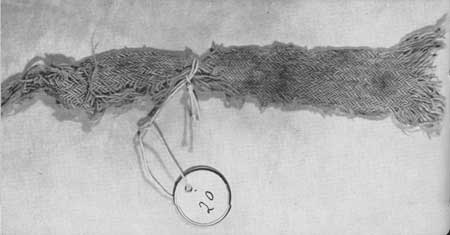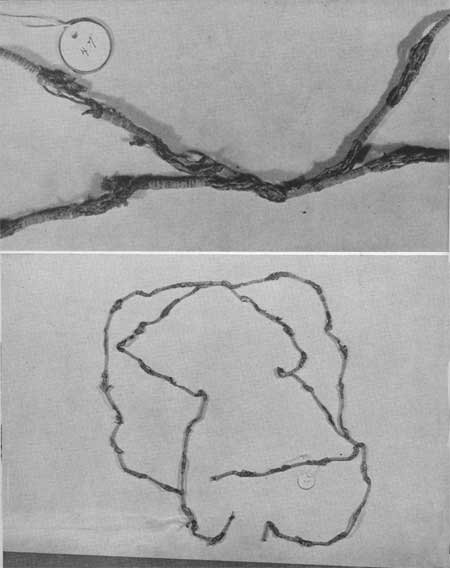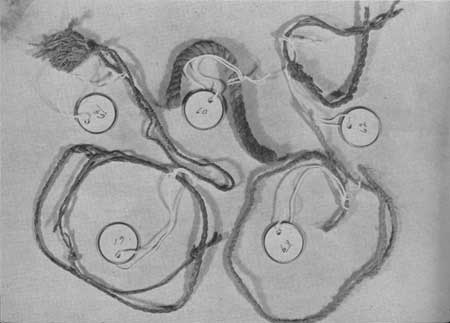|
MONTEZUMA CASTLE
Montezuma Castle Archeology - Part 2: Textiles |

|
CORDS, TIES, BRAIDS, ETC.
(Nos. 47, 48, 57, 60, 63, 64, 59, 20)
The sandal ties have already been described in the section on sandals. All but one of these are of yucca fiber. The exception is one cotton instep cord (No. 27). Six of the sandals have ties of partly-shredded yucca leaves; one has a three-strand yucca fiber braid; one an 11-strand yucca braid.
There are eight other specimens which come under the "cords, ties—" classifications. Of these five are of yucca,25 two of cotton, and one of Agave parryi. It is apparent that yucca was the most common material used for the making of cordage and rope. This is even more obvious if we consider the sandal ties and cords in this connection. Cotton was employed in cases where a minimum of strain was to be placed on the tie. Twisting and braiding were common techniques.
25. Yucca mohavensis—Nos. 59, 60.
Y. elata—No. 48
Y. macrocarpa—Nos. 57, 63.
No. 20 is a braid of 49 cotton strings. It is probably part of a sash, as the one described by Hough (p. 75). See p. 63.
No. 47 has the appearance of a necklace or hair tie of some sort. It is too fragile and elaborate to have been used as a tie where much strain would have been placed on it. It is made of six black (dyed) cotton strands, bound together at 1-inch intervals by white cotton string. There are two ties made in this fashion and fastened together in the center and near each end to make the completed specimen. (See drawing, p. 65.)
No. 59 is a ring of yucca fibers, tied with a square knot. It might well have been a sandal heel strap.
No. 48 is a heavy flat braid of three yucca fiber cords. It is folded and the ends tied in a square knot. One use for such an object is suggested by Kidder and Guernsey (BAEB 65, p. 50) where we see an identical rope figured and described as a loom loop.
No. 57 is composed of two sections of yucca leaves tied at one end in a square knot, and very loosely twisted together.
Nos. 63 and 64 are simple two-strand twists, the former of yucca and, the latter of Agave parryi. No. 64 has a small piece of cotton attached to it, and suggests a tie used to fasten cotton shirts or shawls in place. (Cf. Haury, pp. 84-85, Fig. 16, b, c; Hough, pp. 68-70, Fig. 147, g.)
No. 60 is a fragment of yucca cord, made by twisting three strands together. (Cf. Haury, pp. 84-85; Hough, pp. 68-70, Fig. 147, b.)
There are no apocynum or feather cords, such as those described by Haury (pp. 83-86) and Hough (pp. 70-71).
Braids and cordage similar to the Montezuma specimens are found in prehistoric collections from many Southwestern sites. Many-strand, flat, white cotton braids like No. 20 are very common. They may have been woven between supports like the modern Hopi wedding sashes, or they may have been fabricated in the manner described in this paper.
Specimen 20. Braid
Maximum length: 7-1/2"; 19 cm.
Maximum width: 1-1/16"; 2.7 cm.
Average threads per inch in length: 16; 7 per cm.
Average threads per inch in width: 49 in the total width of the piece.
Material: Cotton.

|
| Figure 34 |
Decoration (see Weave). The cotton is yellow-white in color, M&P 3-A-9. Tinges of yellow in some places. This color seems due to the natural cotton shades, not to dye or rubbed-on paint of any kind.
Weave: A braid of 49 strands. (See illustration; Cf. Hough, p. 75).
To braid: 1. Separate 49 strands into two groups, with 25 strands in the left hand group, and 24 in the right hand group. Number the strands from left to right. Nos. 1 to 25 inclusive will be left of the center in Group A, and Nos. 26 to 49 inclusive will be to the right of the center in Group B. 2. Pass No. 1 over-three under-three (over 2, 3, 4, under 5, 6, 7, etc.) until it crosses to the right of the center and becomes the inner strand of Group B. Now pass No. 49 over-three under-three (over 48, 47, 46, under 45, 44, 43, etc.) until it crosses to the left of the center and becomes the inner strand of Group A. 3. Nos. 2 through 25 pass left to right in the same manner as No. 1, over-three, under-three, until they have replaced all the strands in Group B. Nos. 26 through 48 pass from right to left as did No. 49, until they have replaced all the strands in Group A. They will then be in the position shown below. 4. The process is repeated, always crossing the extreme left hand strand over-three under-three to the right of the center and the extreme right hand strand over-three under-three to the left of the center.

|
| Plate 42. Braid, 49-strand, Specimen No. 20 |
Specimen 47. Necklace (?)
Maximum length: 53"; 134.7 cm.
Width of strand in toto: Average 1/8"; .3 cm. Number of black strands used: six.
Material: Cotton caked with mud. Some strands dyed black.
Description: The six black strands are wrapped with white threads at intervals (average) of 1-3/8" (3.5 cm.). These white threads wrap from 15 to 18 times around the black, covering about 1" (2.5 cm.). The white threads sometimes appear to be colored brown and orange, but no signs of dyeing or rubbing can be found, so this is evidently the natural color of the material. Two black and white strands were produced in the above manner. These were bound together with white thread wrapping in three places: (1) at center; (2) 13" (33.1 cm.) from one end; (3) 5" (12.8 cm.) from the other end. The piece was probably a necklace or ornamental hair tie of some sort, as it is too fragile for use as a belt or tie on which much strain would be placed. Whitford calls it a string for beads.

|
| Plate 43. Necklace, Specimen No. 47 |

|
| Figure 35 |
Specimen 48. Rope (PS No. 36)
Maximum length: (unfolded) 37-1/2"; 95.3 cm.
Maximum width: (when laid flat) 1/2"; 1.2 cm.
Material: Yucca elata
Weave: Three-strand flat braid. Each strand averages 1/4" (.7 cm.) in width, and contains about 116 fibers. A small piece is added on near one end of the rope with a square knot. The piece was folded and the two ends tied together, also by a square knot. (Cf. BAEB 65, p. 50; possibly a loom loop.)

|
| Plate 44. Rope, Specimen No. 48 |

|
| Figure 36 |
Specimen 57. Tie
Maximum length: 5-1/2"; 14 cm.
Width of strands used: 1/8"; .3 cm.
Material: Yucca macrocarpa.
Description: This is a piece of what must have been a very coarse tie. It is made of two sections of yucca leaves twisted, and tied at one end with a square knot. The twist has been much loosened. (Cf. Hough, pp. 67-70; Haury, pp. 83-88.)

|
| Plate 45. Braids, ties, Specimens Nos. 57, 59 |
Specimen 59. Ring of yucca
Description: Ring of Yucca mohavensis fibers tied with a square knot. The average diameter of the ring is 1-1/4"; 3.2 cm. The width of the strand is 1/8"; .3 cm. (Cf. Hough, p. 67.)
Specimen 60. Rope (PS No. 13)
Maximum length: 5-1/2"; 14 cm.
Maximum width: 5/16"; .8 cm.
Width of strands used: 1/8"; .3 cm. each. ca. 150 fibers per strand. 6 twists per inch; nearly 3 per cm.
Material: Yucca mohavensis.
Weave: Simple, three-strand twist. (Cf. Haury, pp. 84-85; Hough, pp. 68-70, and Fig. 147, b.)

|
| Figure 37 |
Specimen 63. Twine
Maximum length: 16"; 40.7 cm. Maximum width: 1/8"; .3 cm.
Material: Yucca macrocarpa.
Weave: Two strands twisted together. Each of these is composed of two smaller strings tightly twisted; about 32 fibers in each of the small strings. There are nine twists of the strands per inch; four per cm.

|
| Figure 38 |
Specimen 64. Twine
Maximum length: (Agave strand) 5-1/2"; 14 cm.
Maximum width: (Agave strand) 1/16"; .2 cm.
Material: Cord, Agave parryi; fabric, cotton.
Weave: This is a slender two-ply twisted cord with a piece of cotton cloth knotted to one end. It might have been a tie loop fastened to a cotton shirt or shawl. The cord is doubled and the ends tied in a square knot. To one arm of the square knot a piece of cotton is fastened. Length of cotton: 2"; 5 cm. Width of cotton: 1/2"; 1.3 cm. Stitch count: 14 threads per inch; 7 per cm.

|
| Plate 46. Ties, cords, Specimens Nos. 60, 63, FD |

|
| Figure 39 |
| <<< Previous | <<< Contents>>> | Next >>> |
wnpa/tech/3-2/sec4.htm
Last Updated: 04-Mar-2008
Western National Parks Association